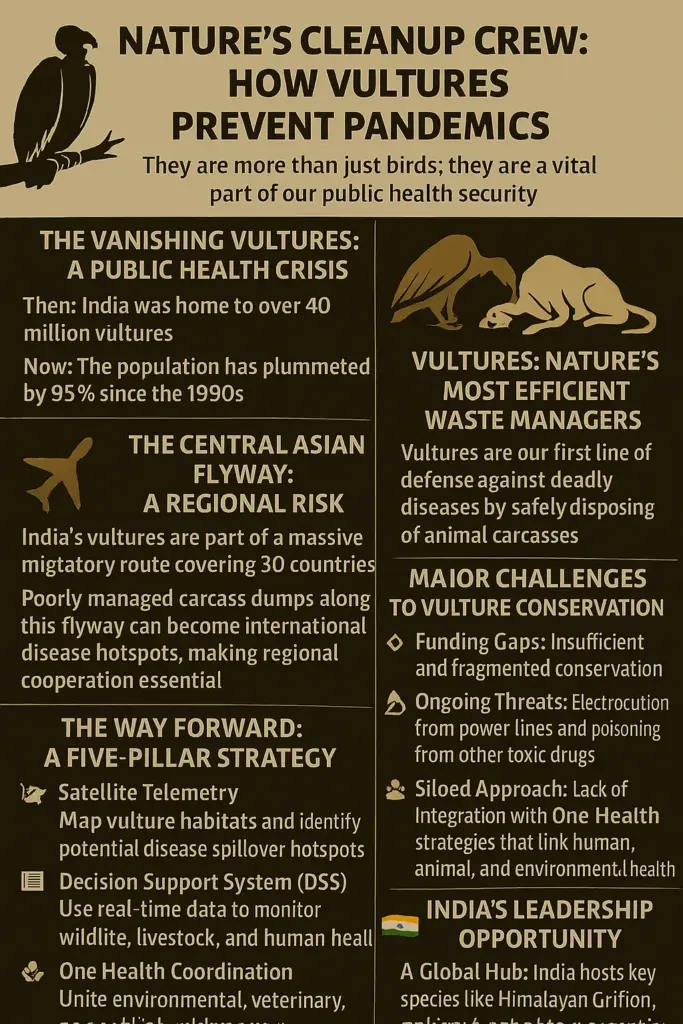September 12, 2025
Vulture Conservation: A Vital Strategy Revealed in 5 Essential Pillars
Vultures and Pandemic Preparedness
India’s vulture population has declined drastically since the 1990s, raising public health concerns. Experts are calling for integrating vulture conservation with pandemic prevention strategies, highlighting their role in controlling zoonotic diseases and maintaining ecological balance.
Key Points: Vultures and Pandemic Preparedness
Role of Vultures in Public Health:
- Vultures are nature’s most efficient waste managers, preventing the spread of diseases like anthrax, rabies, and botulism by consuming animal carcasses.
- Historically, India had 40+ million vultures, but the population dropped by 95% due to the veterinary drug diclofenac.
- Their absence has led to increased carcass decay, rising stray dog populations, and higher risk of zoonotic spillovers.
Central Asian Flyway (CAF):
- India’s vultures are part of the CAF migratory route, connecting Central Asia to South Asia, covering over 30 countries.
- Poorly managed carcass dumps and landfills along this route can become disease hotspots, emphasizing the need for regional cooperation.

Link to Pandemic Risks:
- Vultures are the first responders to carcasses, reducing chances of pathogens spreading to humans and livestock.
- Without vultures, carcasses remain exposed, increasing the likelihood of zoonotic outbreaks.
- Conservation is thus directly tied to pandemic preparedness.
Challenges in Vulture Conservation:
- Underfunding and fragmented conservation efforts.
- Electrocution from power lines and poisoning from toxic drugs remain major threats.
- Lack of integration with One Health strategies that combine human, animal, and environmental health.
Way Forward: Five-Pillar Strategy (Post-2025):
- Satellite Telemetry: Mapping habitats, carcass dumps, and spillover hotspots.
- Decision Support System (DSS): Real-time monitoring of wildlife, livestock, and human health data.
- One Health Coordination: Linking environment, veterinary, and public health agencies.
- Regional Collaboration: Strengthening cross-border efforts through CAF and the Convention on Migratory Species.
- Community Stewardship: Engaging women, youth, and local groups in surveillance and awareness campaigns.
India’s Opportunity:
- India hosts key vulture species like the Himalayan Griffon and Cinereous Vulture, giving it a leadership role in CAF conservation.
- Investment in vulture conservation is cost-effective, far cheaper than pandemic response.
- Aligns with WHO South-East Asia Regional Health Security Roadmap (2023–27).
Conclusion:
By protecting vultures, India can:
- Safeguard biodiversity,
- Reduce zoonotic spillover risks, and
- Position itself as a global leader in biodiversity-driven pandemic prevention.
Vultures soaring in the sky are not just an ecological indicator, but a vital part of public health security.
October 6, 2025
September 24, 2025
September 23, 2025
September 22, 2025
